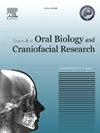Anti-cariogenic potential and pharmacokinetics of Licorice and Xylitol infused chewing gum
Q1 Medicine
Journal of oral biology and craniofacial research
Pub Date : 2025-04-04
DOI:10.1016/j.jobcr.2025.03.012
引用次数: 0
Abstract
Background
Dental caries remains a global health challenge despite advancements in prevention. Traditional approaches focus on mechanical plaque removal and fluoride use, but innovative, non-invasive solutions are increasingly sought. Chewing gum, as a delivery system for bioactive ingredients, offers a convenient method for improving oral health. Xylitol, licorice, and lemon balm, known for their anti-cariogenic and antimicrobial properties, were incorporated into a novel chewing gum to evaluate its potential in preventing caries.
Methods
The chewing gum was formulated using beeswax, glycerin monostearate, xanthan gum, xylitol, lemon balm, and licorice. Physicochemical properties were assessed through Fourier-transform infrared spectroscopy (FTIR) and X-ray diffraction (XRD). Rheological properties, including elasticity and viscosity, were analyzed to ensure optimal texture. Antimicrobial activity was evaluated using the Minimum Inhibitory Concentration (MIC) method against key cariogenic bacteria, while flavor dynamics and in-silico docking and ADMET analysis provided additional insights.
Results
FTIR and XRD confirmed the successful integration of bioactive components and an amorphous matrix structure, promoting controlled release and stability. Antimicrobial assays showed the gum's effectiveness against Streptococcus mutans (MIC 0.20 mg/mL), with varying efficacy against other pathogens. Rheological analysis revealed xanthan gum as a key contributor to elasticity and viscosity, ensuring chewability and stability. Flavor release dynamics highlighted prolonged taste perception, with licorice providing sustained intensity. In-silico analysis supported the bioavailability and favorable pharmacokinetics of the ingredients.
Conclusion
This novel chewing gum demonstrates significant potential as an anti-cariogenic product with a balanced formulation of functional, structural, and sensory properties. Future research, including clinical trials and consumer testing, will be essential to optimize its effectiveness and marketability, addressing the demand for user-friendly oral health solutions.
甘草和木糖醇口香糖的抗龋潜能及药代动力学研究
尽管在预防方面取得了进展,但龋齿仍然是一个全球性的健康挑战。传统的方法侧重于机械清除斑块和使用氟化物,但越来越多地寻求创新的非侵入性解决方案。口香糖作为一种生物活性成分的输送系统,为改善口腔健康提供了一种方便的方法。木糖醇、甘草和柠檬香蜂草,以其抗龋齿和抗菌特性而闻名,被纳入一种新型口香糖中,以评估其预防龋齿的潜力。方法采用蜂蜡、单硬脂酸甘油、黄原胶、木糖醇、柠檬香蜂草和甘草配制口香糖。通过傅里叶变换红外光谱(FTIR)和x射线衍射(XRD)对其理化性质进行了评价。流变特性,包括弹性和粘度分析,以确保最佳的织构。采用最小抑制浓度(MIC)法对主要致龋细菌进行抗菌活性评估,而风味动力学、硅对接和ADMET分析提供了额外的见解。结果ftir和XRD证实了生物活性成分与无定形基质结构的成功结合,促进了控释和稳定性。抗菌试验表明,该口香糖对变形链球菌(MIC为0.20 mg/mL)具有抑制作用,对其他病原菌的抑制效果也各不相同。流变学分析表明黄原胶是弹性和粘度的关键因素,确保了咀嚼性和稳定性。香味释放动力学强调了持久的味觉感知,甘草提供了持续的强度。计算机分析支持了该成分的生物利用度和良好的药代动力学。结论该新型口香糖具有良好的功能性、结构性和感官性,是一种极具潜力的抗龋产品。未来的研究,包括临床试验和消费者测试,对于优化其有效性和适销性至关重要,以满足对用户友好的口腔健康解决方案的需求。
本文章由计算机程序翻译,如有差异,请以英文原文为准。
求助全文
约1分钟内获得全文
求助全文
来源期刊

Journal of oral biology and craniofacial research
Medicine-Otorhinolaryngology
CiteScore
4.90
自引率
0.00%
发文量
133
审稿时长
167 days
期刊介绍:
Journal of Oral Biology and Craniofacial Research (JOBCR)is the official journal of the Craniofacial Research Foundation (CRF). The journal aims to provide a common platform for both clinical and translational research and to promote interdisciplinary sciences in craniofacial region. JOBCR publishes content that includes diseases, injuries and defects in the head, neck, face, jaws and the hard and soft tissues of the mouth and jaws and face region; diagnosis and medical management of diseases specific to the orofacial tissues and of oral manifestations of systemic diseases; studies on identifying populations at risk of oral disease or in need of specific care, and comparing regional, environmental, social, and access similarities and differences in dental care between populations; diseases of the mouth and related structures like salivary glands, temporomandibular joints, facial muscles and perioral skin; biomedical engineering, tissue engineering and stem cells. The journal publishes reviews, commentaries, peer-reviewed original research articles, short communication, and case reports.
 求助内容:
求助内容: 应助结果提醒方式:
应助结果提醒方式:


